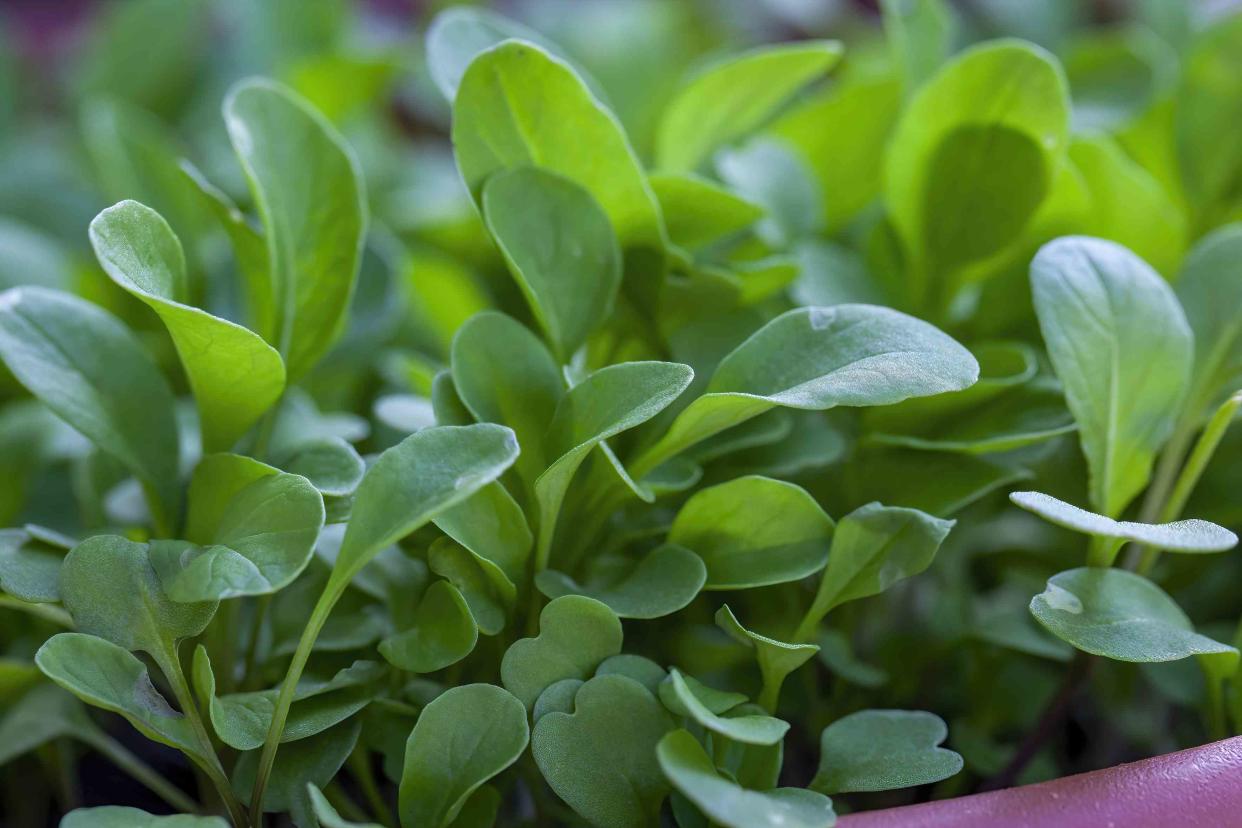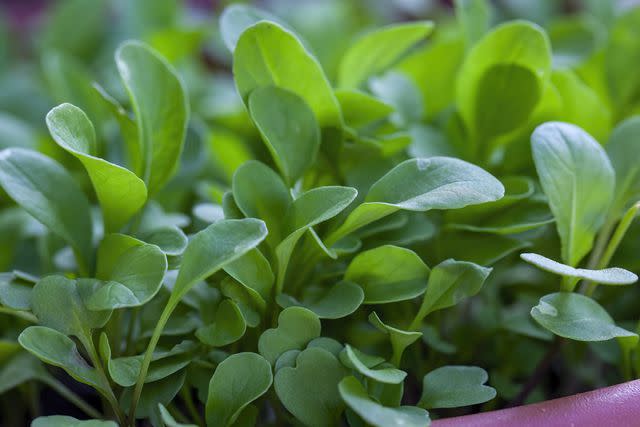Watercress: Everything You Need to Know

Ali Majdfar / Getty Images
WatercressWatercress, or Nasturtium officinale, is a leafy green vegetable with a peppery taste and several nutritional benefits.
The plant grows near water and is a good source of polyphenols, which are compounds with antioxidant properties that protect cells from damage.
Watercress has been used in traditional medicine for cough, asthma, high blood pressure, and diabetes.
This article discusses the potential benefits of watercress, its nutrition, and safety.
Dietary supplements are not regulated the way drugs are in the United States, meaning the Food and Drug Administration (FDA) does not approve them for safety and effectiveness before products are marketed. Whenever possible, choose a supplement tested by a trusted third party, such as U.S. Pharmacopeia (USP), ConsumerLab.com, or NSF.org. However, even if supplements are third-party tested, they are not necessarily safe for all or effective in general. Therefore, talking to your healthcare provider about any supplements you plan to take and asking about potential interactions with other supplements or medications is essential.
Supplement Facts
Active ingredients: Vitamin K, antioxidants (beta-carotene, alpha-tocopherol, 2-phenethyl isothiocyanate)
Alternate name: Nasturtium officinale
Legal status: Over-the-counter supplement, food
Suggested dose: Unknown
Safety considerations: May interact with alcohol, caffeine, and blood thinners; may contribute to kidney stones
Uses of Watercress
There are very few clinical trials studying the effects of watercress in humans.
Limited data suggest it may help prevent cancer or recurrent infections, or decrease cholesterol levels.
Here's the latest science behind these uses.

Ali Majdfar / Getty Images
WatercressMay Lower Cancer Risk
Though watercress has been shown to have anticancer activity in animal models, little data exists to support this effect in humans.
A study in adults who smoked suggested a special natural component (chemical) in watercress may have slowed the activation of a lung carcinogen (cancer-causing agent). This could decrease the risk of lung cancer.
However, more research is needed.
May Prevent Recurrent Infections
A combination of watercress and horseradish taken for 90 days was shown to decrease recurrent urinary tract infections in a clinical trial.
And a larger trial in adults showed a lower rate of respiratory infections in those taking a combination of watercress plus horseradish compared to those taking a placebo.
Remember that it's yet to be determined whether this combination would be similarly effective for children or older people since these groups have not been studied.
And it's impossible to know how effective watercress alone prevents these infections since it was combined with horseradish in these studies.
May Lower Cholesterol
A small study was done in people that were overweight and who had physical disabilities.
Those who took a standardized watercress extract for five weeks had lower low-density lipoprotein (LDL) cholesterol (considered bad cholesterol) than those who took a placebo.
However, the watercress extract did not significantly affect total cholesterol or high-density lipoprotein (HDL) cholesterol (considered good cholesterol).
Larger trials are needed to determine the effect of watercress on cholesterol.
May Protect Against Exercise-Induced Stress
Another small study of healthy males suggests that antioxidants like beta-carotene and alpha-tocopherol found in watercress may protect against unstable molecules known as free radicals formed during intense cardio exercise.
More robust research is undoubtedly needed to verify this result.
Before taking watercress, involve a registered dietitian nutritionist (RD or RDN), pharmacist, or healthcare provider to help you achieve your health goals.
Nutrition
According to the United States Department of Agriculture (USDA), the following nutrition is found in 1 cup, equal to 34 grams (g), of chopped raw watercress.
Watercress Nutrition
Calories: 3.74
Carbohydrates: 0.44 g
Fiber: 0.17 g
Protein: 0.78 g
Fat: 0.034 g
Calcium: 41 milligrams (mg)
Magnesium: 7 mg
Phosphorus: 20 mg
Potassium: 112 mg
Vitamin C: 15 mg
Vitamin A: 55 micrograms (mcg) or 1080 International Units (IU)
Beta-carotene: 649 mcg
Lutein & zeaxanthin: 1,960 mcg
Most of watercress is pure water. There are also many vitamins and minerals in watercress.
One cup has 85 micrograms (mcg) of vitamin K, close to the recommended daily allowance for adults.
It also contains antioxidants such as beta-carotene and alpha-tocopherol.
How to Use Watercress
Watercress can easily be incorporated into your diet in many ways. For instance, some people enjoy it as the following:
A raw ingredient in a salad
Added to smoothies or soups
Wilted with pasta or meats
To reduce the risk of foodborne illness, wash watercress in water right before eating or preparing it.
If the watercress is labeled "prewashed," there's no need to rewash it at home. However, refrigerate it within an hour or two.
Once washed or cut, store watercress in the refrigerator, where it will typically last for a few days.
To provide the greatest amount of antioxidants, watercress should be eaten raw or steamed. Boiling is not recommended because it can result in a loss of nutritional benefits.
Precautions
People who are at risk of developing kidney stones should be careful about eating watercress. That's because it's high in oxalates, which can cause kidney stones.
There is not enough safety data to know if large amounts of watercress are safe during pregnancy and lactation. Anecdotally it's thought to induce labor; check with your healthcare provider for more guidance.
Large amounts of watercress may slow down the metabolism of alcohol. Be cautious if you choose to imbibe (drink alcohol). It could increase the alcohol's effects on your body.
Avoid watercress if you have a known allergy to it or any of its components (ingredients or parts). Ask a registered dietitian nutritionist (RD or RDN), pharmacist, or healthcare provider for more information if you're unsure.
What Are the Side Effects of Watercress?
Although consuming watercress as part of a healthy diet is generally a wise choice, there are some potential side effects. These may be mild or severe.
Common Side Effects
Mild side effects of watercress include the following:
Severe Side Effects
And aquatic plants like watercress may contain parasites that cause a disease called fascioliasis. Some parasitic symptoms include the following:
Fatigue
Fever
Talk to your healthcare provider if you have symptoms of a parasitic infection.
Interactions
The following interactions may be possible with watercress:
Blood thinners: Watercress is high in vitamin K. It may interact with blood thinners like Jantoven (warfarin). If you take warfarin, keep your daily intake of leafy green vegetables like watercress consistent. Eating different amounts of watercress daily could cause heavy bleeding or blood clots.Medications broken down by the liver: Eating large amounts of watercress may cause interactions with some medications broken down by the liver. In particular, watercress may interact with medicines processed by an enzyme called cytochrome P450 1A2 and cause altered levels of these drugs in the body. Examples of drugs that could interact with watercress are caffeine and Zanaflex (tizanidine). Eating about 1.5 cups, or 50 g, of watercress may increase the levels of substances like alcohol and chlorzoxazone broken down by another liver enzyme, cytochrome P450 2E1.
Speak with your pharmacist or healthcare provider if you have questions about your medication and how it may interact with supplements or foods like watercress.
Dosage: How Much Watercress Should I Take?
Always speak with a healthcare provider before taking a supplement to ensure that the supplement and dosage are appropriate for your individual needs.
There isn't a specific recommended dose for watercress.
In clinical trials, a dose of 750 milligrams per kilogram of body weight (mg/kg) of watercress extract daily has been studied in people who were overweight for its effects on cholesterol.
And 85 grams of raw watercress was used in a trial of exercise-induced stress.
Similar Supplements
Watercress has similar health benefits as related vegetables like the following:
Broccoli
Cauliflower
Cabbage
Kale
Bok choy
Arugula
Brussels sprouts
Collard greens
Radishes
Summary
Watercress is an aquatic plant considered a nutritional powerhouse because of its high levels of antioxidants and vitamins.
While it may be a healthy food choice to add to your diet, it's unlikely to have dramatic therapeutic effects. It's possible it could decrease the risk of cancer or recurrent infections, lower cholesterol, or the stress caused by exercise. But keep in mind that there are only a few small studies of watercress in humans. More research is needed before routinely recommending it for any of these uses.
Some people should be cautious before eating watercress, especially in large amounts. There's not enough data to know if it's safe for children in concentrated amounts, or during pregnancy or breastfeeding. People at risk of developing kidney stones should talk with a healthcare provider before eating watercress regularly. And levels of caffeine, alcohol, and blood thinners can be altered if taken with watercress.
Frequently Asked Questions
What is watercress?
Watercress is a leafy green vegetable that grows near water. It's cruciferous and related to other veggies like broccoli, cauliflower, kale, and arugula.
What does watercress taste like?
Watercress is known for its distinctive peppery flavor.
Is watercress good for you?
Watercress has antioxidant properties that help protect against the effects of unstable molecules known as free radicals that can damage cells in the body. It's also been shown to protect against diabetes, cancer, and inflammation in test tube and animal studies, though clinical trials in humans are still minimal.

